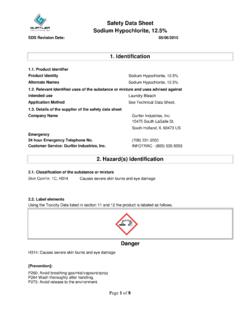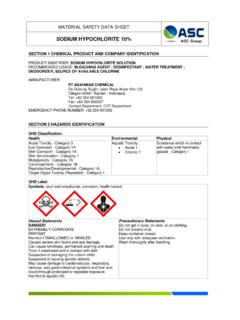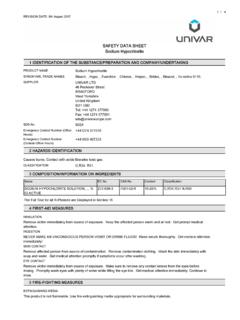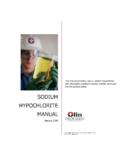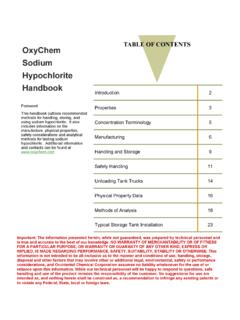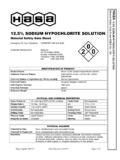Transcription of Bromate in Sodium Hypochlorite--Potable Water …
1 THECHLORINE INSTITUTE, in Sodium Hypochlorite--Potable Water TreatmentGeneralOn December 16, 2001,Stage I of the Disinfectants / Disinfection Byproducts Rule will require potablewater plants to meet a Bromate of 10 parts per billion (ppb) in their effluents. Plants that use ozonein their treatment process will be required to test monthly for Bromate . Plants that do not use ozone, but usesodium hypochlorite solutions will not need to test, they will be protected by certification to ANSI / NSFS tandard # 60 and/or the AWWA Standard for Hypochlorites.
2 Industry is working with both organizationsto develop specifications that easily meet this The Sodium hypochlorite Industry wants to providea realistic safety margin so that testing for Bromate will not be required in potable Water treated with thischemical. How did Bromates Get into Sodium hypochlorite & Can they be Removed?Bromide ions are found in the salt used to make both chlorine and Sodium hydroxide, the two raw materialsreacted to form Sodium hypochlorite . Virtually all of the bromine in chlorine and the bromide in the sodiumhydroxide quickly becomes Bromate at the pH of NaOCl.
3 The concentration of bromide variestremendously in different salt sources. It also partitions between the two chemicals (chlorine and sodiumhydroxide) differently depending on the type of electrochemical cells used in the process. Some plants canchange their source of salt, while others are located near salt mines and are limited to the salt they haveavailable. Current technology cannot easily or economically remove Bromate or its precursor from eitherthe initial salt, the two reactants or the final Sodium hypochlorite solution.
4 However, there are othersolutions to the Should My Facility Be Doing About This Issue?If your plant uses Sodium hypochlorite , but does not ozonate, chemicals certified to meet ANSI / NSFS tandard # 60 will allow you to easily meet the new Bromate up to the maximum dosage dictatedin Standard # 60. The committee overseeing the AWWA hypochlorite Standard will consider this issueat its meeting in Denver in June of 2000. You should also be in contact with your supplier of sodiumhypochlorite and make certain they are taking the steps necessary to produce a viable product that will meetor exceed the proposed standards for if Your Facility Uses Both Ozone and Sodium hypochlorite ?
5 There are some facilities that use both of these disinfectants. Plants using ozone will be required to test forbromate. The ozonation of Water containing bromide ions can produce Bromate as well as brominatedorganic compounds. The amount of Bromate produced varies tremendously from plant to plant and dependson bromide ion concentrations, organic carbon levels and other plant-specific treatment , plants using ozone should work with their Sodium hypochlorite supplier to ensure that thecombination of ozonation and Sodium hypochlorite do not exceed the Bromate Some of these sitesmay wish to consider disinfecting with gaseous chlorine which does not produce Bromate .
6 A nationalstandard is not practical as there are two different and variable sources of Has Industry Done And What Is It Doing to Resolve This Issue?The Sodium hypochlorite industry became aware of this possible issue in 1997 at a Water industryconference. At this conference a speaker from the UK reported unpublished information indicating highlevels of Bromate in Sodium hypochlorite in the UK. Later that year the industry surveyed ten sodiumhypochlorite manufacturing sites and learned that while US Sodium hypochlorite Bromate levels are muchlower than those in the UK, the US Sodium hypochlorite can be a significant source of Bromate in finishedwater.
7 The samples in this survey varied considerably from site to site without any apparent geographicaltrend. The industry informed EPA of this data in 1998. The industry then prepared a strategy to identify the sources of Bromate in hypochlorite and developmethods to control the level of Bromate in Sodium research was extremely complexrequiring the development of new analytical techniques for the measurement of Bromate and bromateprecursors in chlorine, Sodium hydroxide and Sodium hypochlorite . The industry used these new analyticaltechniques to study chlor-alkali plants and learned that mercury cell and membrane cell plants tend topartition virtually all of the bromide from the salt into the chlorine while diaphragm cell plants place most(70% to 80%) of the bromide into the Sodium hydroxide.
8 This information allows Sodium hypochlorite manufacturers to select raw materials from processes andproduction sites that are lower in Bromate precursors. In addition, the study indicated that all of the bromineor bromide in these two chemicals converts quickly to Bromate at the high pH and strength of , the chlorine industry has developed a computer program that allows Sodium hypochloritemanufacturers to determine the final Bromate concentration in their Sodium hypochlorite based on thebromide concentrations in their raw , the industry did a second national survey of Bromate in NaOCl with the help of an independentUniversity in Wichita, Kansas.
9 Over 60 samples were received and the results were consistent with theinitial survey. The EPA, AWWA and NSF also received these Chlorine Institute has educated the industry about this problem, as well as, the EPA, the NSF and theAWWA. We are now working with Sodium hypochlorite producers on reducing the levels of bromates intheir products. At the same time, we are working with the NSF and the AWWA to develop realistic waterindustry standards. These must allow Water plants using Sodium hypochlorite to meet the with anadequate margin of safety and at the same time provide viable sources of this chemical for drinking watertreatment in the future.
10 Additional Information From The Chlorine InstituteThe Chlorine Institute publishes Pamphlet # 96, Sodium hypochlorite Manual on Sodium hypochloriteand produced a safety video on this chemical. The Institute also publishes Pamphlet # 155 with anaccompanying video covering the safe use of packaged chlorine for Water and wastewater operators. Visit the Publications section of CI=s web site at for pricing and ordering informationfor these and other publications.









